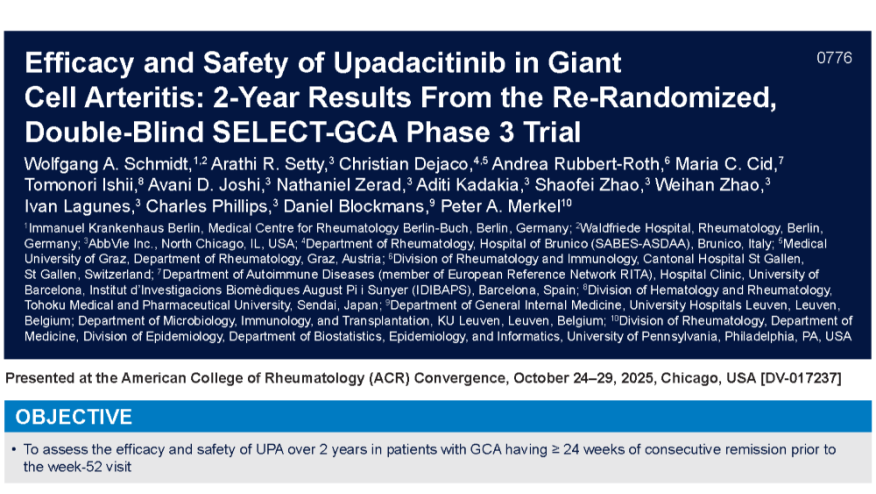Steroid Tapering in PMR: What's the Gold Standard? Save
Hi, I'm Anisha Dua and I'm an associate professor at Northwestern University, and I'm talking to you guys today from Chicago, Illinois. Today I will be talking about the gold standard tapering of glucocorticoids and polymyalgia rheumatica or PMR. Now, whenever we talk about a gold standard, it gets tricky because in practice, so many factors influence the way that we approach glucocorticoids and tapering in PMR. But I'll start off with describing the ACR EULAR guidelines that were developed in 2015. Now remember, these are guidelines based on the best available data at that time, and they're intended for guiding practicing clinicians, but they're not rules for managing every PMR patient.
So point one: the guidelines recommend using the minimum effective glucocorticoid dose for initial treatment, and the range provided is between 12 and a half and 25 milligrams of prednisone daily.
Now, there was unanimous agreement that patients requiring higher doses, more than 30 milligrams of glucocorticoids, should really be assessed for an alternative diagnosis because there's really not a lot of evidence for a benefit from a higher dose regimen in PMR. They also discourage using a starting dose of less than seven and a half milligrams. But within this range, which side do you pick? In patients with a higher risk of relapse and low risk for adverse events, you might opt for the higher dose range, and in patients at a lower risk of relapse or with significant comorbidities, you might opt for starting at the lower dose range. But this begs the question, who are these people who have a higher risk of relapse? Factors include female sex, highly elevated inflammatory markers, and that's defined as a said rate of more than 40, and those who have peripheral inflammatory arthritis.
Now, comorbidities that might influence a provider to use doses in the lower range include things like diabetes, osteoporosis, glaucoma, and so on. Now, in practice, the majority of patients will fall into this high risk relapse group. Females with a SED rate more than 40, but many of them will also have a comorbidity that makes you want to start a lower dose if possible.
What do I generally do?
This is point two. In most of my PMR patients, I start with a dose of 15 milligrams daily. Fewer than 1% of patients with PMR initially treated with prednisone doses of 15 milligrams a day require higher doses to control their symptoms. And typically we see very rapid improvement with the initiation of glucocorticoids, usually within a few days. But if the symptoms don't improve in two to four weeks, the diagnosis really should be reconsidered.
Okay, so what's next? How do we actually taper?
Once the patient achieves clinical remission, the guidelines recommend that glucocorticoid should be tapered to a dose of 10 milligrams a day within four to eight weeks. If they continue to do well, then the prednisone should be tapered by one milligram every four weeks. Of course, if you don't have one milligram tablets, you can use alternate date dosing, for example, seven and a half, alternating with five milligrams every other day. But based on this regimen, a perfectly responding patient with PMR can be tapered off of glucocorticoids at a minimum of 10 months from their first prednisone dose.
I do have some incredible colleagues who are a little bit bolder than I am and attempt to taper their patients off of glucocorticoids in 12 to 16 weeks from their diagnosis of PMR. Now, this is based on data from the placebo arms of some randomized control trials in PMR where about 20% of patients are able to rapidly taper the prednisone without having flares. Of course, in the other 80%, the dose can be increased when they do relapse. But this brings up the point that for those who relapsed during glucocorticoid tapering, the prednisone dose should be increased to the pre relapse dose and then decrease gradually within four to eight weeks to the dose at which that relapse occurred.
Point three. I'm personally not as aggressive in my steroid tapering regimen, and I tend to stick closer to the guidelines in terms of getting to about 10 milligrams daily after eight weeks, and then tapering closer to about one to two milligrams about every six weeks. Of course, taking into account patient comorbidities and tolerance. The other thing that the guidelines recommend is using daily dosing instead of B I D dosing, so as to not disrupt the H P A access. And in most patients, I do use daily dosing, but in patients with prominent nighttime pain or symptoms, it's reasonable to use split dosing with the higher doses in the morning. Now, in real life, a systematic review of PMR patients show that many patients with PMR are still on glucocorticoids way beyond the time of their diagnosis. 77% at one year, 51% at two years, and 25% still on glucocorticoids at five years.
We also know that about 65% of PMR patients develop glucocorticoid related adverse effects. So in an ideal world, we would have predictive factors or biomarkers that would help us to risk stratify these patients in regards to relapse risk and identify the best tapering strategy based on this. Currently that doesn't exist, and patients with PMR often deal with significant side effects from glucocorticoids and remain on prolonged therapy.
Luckily, there have been advancements in the field that have created a path for using other medications to enable glucocorticoid tapering in our patients, especially those who don't tolerate steroids or who flare while the steroids are tapered.
So all of what I just told you basically means that there is no gold standard for tapering steroids in PMR. As providers, we have to individually assess each patient and taper as quickly as we can while keeping the debilitating symptoms of their disease under control. My recommendation would be to start around 15 milligrams of prednisone daily, taper by two and a half milligrams every month until 10 milligrams daily, and then continue to try to taper at a rate of one to two milligrams every six weeks while monitoring clinical symptoms and inflammatory markers. And don't forget to screen for signs and symptoms of concomitant GCA at each visit with your PMR patients.
Thanks so much for listening.
Join The Discussion
Thank you for this nice review of PMR. Although it is a fairly common disease, it does not get much medical press. Having managed hundreds of patients with PMR, I fully agree with your therapy outline in the last paragraph. Some patients require the prednisone 1 mg step-down withdrawal approach under 10 mg. Occasionally, a 0.5 mg reduction is needed in those tending to flare readily.











If you are a health practitioner, you may Login/Register to comment.
Due to the nature of these comment forums, only health practitioners are allowed to comment at this time.